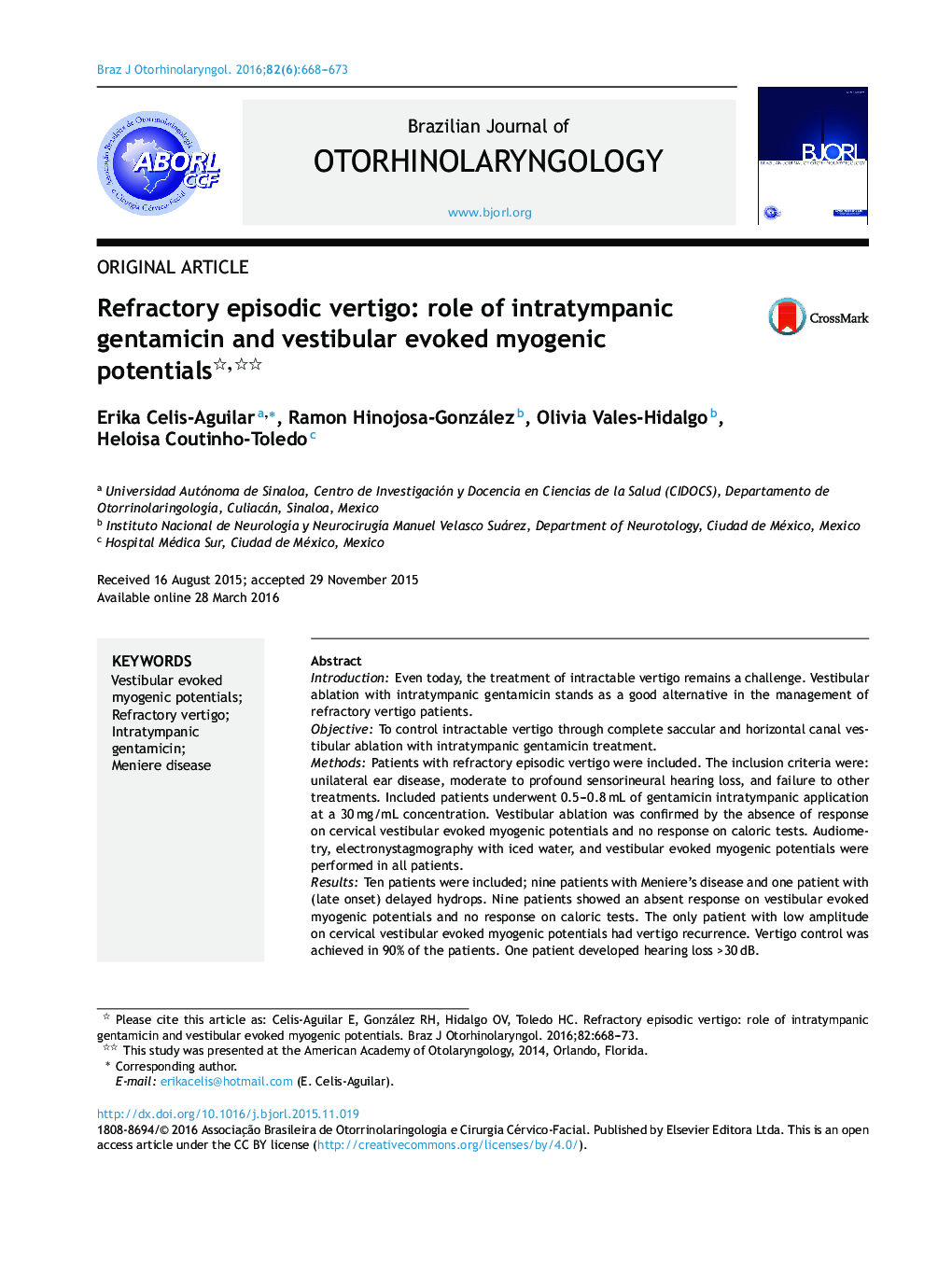| Article ID | Journal | Published Year | Pages | File Type |
|---|---|---|---|---|
| 5714062 | Brazilian Journal of Otorhinolaryngology | 2016 | 6 Pages |
IntroductionEven today, the treatment of intractable vertigo remains a challenge. Vestibular ablation with intratympanic gentamicin stands as a good alternative in the management of refractory vertigo patients.ObjectiveTo control intractable vertigo through complete saccular and horizontal canal vestibular ablation with intratympanic gentamicin treatment.MethodsPatients with refractory episodic vertigo were included. The inclusion criteria were: unilateral ear disease, moderate to profound sensorineural hearing loss, and failure to other treatments. Included patients underwent 0.5-0.8Â mL of gentamicin intratympanic application at a 30Â mg/mL concentration. Vestibular ablation was confirmed by the absence of response on cervical vestibular evoked myogenic potentials and no response on caloric tests. Audiometry, electronystagmography with iced water, and vestibular evoked myogenic potentials were performed in all patients.ResultsTen patients were included; nine patients with Meniere's disease and one patient with (late onset) delayed hydrops. Nine patients showed an absent response on vestibular evoked myogenic potentials and no response on caloric tests. The only patient with low amplitude on cervical vestibular evoked myogenic potentials had vertigo recurrence. Vertigo control was achieved in 90% of the patients. One patient developed hearing loss >30Â dB.ConclusionsCervical vestibular evoked myogenic potentials confirmed vestibular ablation in patients treated with intratympanic gentamicin. High-grade vertigo control was due to complete saccular and horizontal canal ablation (no response to iced water in electronystagmography and no response on cervical vestibular evoked myogenic potentials).
ResumoIntroduçãoAinda hoje, o controle da vertigem intratável permanece um desafio. A ablação vestibular com gentamicina intratimpânica permanece como uma boa alternativa no tratamento de pacientes com vertigem refratária.ObjetivoControlar a vertigem intratável por meio de ablação vestibular completa dos canais sacular e horizontal com gentamicina intratimpânica como tratamento.MétodoPacientes com vertigem refratária episódica foram incluÃdos. Os critérios de inclusão foram doença unilateral da orelha, perda auditiva neurossensorial de moderada a profunda e fracasso com outros tratamentos. Os pacientes incluÃdos receberam uma aplicação de 0,5-0,8 mL de gentamicina intratimpânica com concentração de 30 mg/mL. A ablação vestibular foi confirmada pela ausência de resposta no teste de potencial evocado miogênico vestibular cervical (PEMVc) e nenhuma resposta nas provas calóricas. Audiometria, eletronistagmografia com água gelada e potencial evocado miogênico vestibular foram realizados em todos os pacientes.ResultadosAo todo, dez pacientes foram incluÃdos: nove com doença de Ménière e um com hidropisia tardia. Nove pacientes apresentaram ausência de resposta no teste de potencial evocado miogênico vestibular e nenhuma resposta na prova calórica. O único paciente com baixa amplitude no PEMVc apresentou recorrência da vertigem. O controle da vertigem foi obtido em 90% dos pacientes. Um paciente desenvolveu perda auditiva > 30 dB.ConclusõesO PEMVc confirmou ablação vestibular nos pacientes tratados com gentamicina intratimpânica. O alto grau de controle da vertigem foi devido à ablação completa do sáculo e canal horizontal (sem resposta à água gelada na eletronistagmografia e ausência de resposta no PEMVc).
